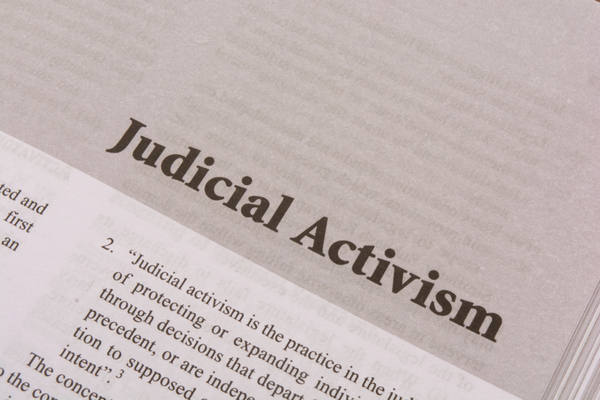Judicial review represents the authority to refuse a law, but not authority to create or replace a law.
It is grounded in three principles:
- the Constitution is the supreme law of the United States,
- the Supreme Court possesses the ultimate authority in constitutional rulings, and
- the judiciary is obligated to rule against any law that conflicts with the Constitution.
The Constitution’s words matter, literally and (where explanation is necessary) the founders' writings are sourced to explain rejection or confirmation.
Judicial restraint should be the essential process applied in the Supreme Court’s actions in its functional responsibility to provide judicial review of Congressionally created law.
First, let's look at the origins of judicial review. In 1803 Chief Justice John Marshall decided Madison, 5 U.S. (1 Cranch) 137 (1803), a case revolving around appointments based on Congressional legislation containing court restructuring. John Adams' end-of-term appointments remained undelivered by President Thomas Jefferson’s appointed Secretary of State. Marbury brought suit.
The Supreme Court unanimously declared that the law (passed by Congress) was unenforceable, because it was in opposition to constitutional authority assigned Congress, which required a constitutional amendment to legitimize its legislative act.
This was the first Supreme Court case which applied a principle of judicial review, recognizing the power of federal courts to void acts of Congress conflicting with constitutional principles.
So how did judicial review--as applied by the Supreme Court--drift to judicial activism?
Originalist Robert Bork observed and articulated the judicial role, (as found in Federalist 78), stating judicial activism’s flaw: “Either the Constitution and statutes are law, which means that their principles are known and control judges, or they are malleable texts that judges may rewrite to see that particular groups or political causes win.”
Activist judges make rather than interpret law from a constitutional understanding.
Perhaps Thurgood Marshalls' disparaging opinion of the Framers stimulated it when he said, “I do not believe that the meaning of the Constitution was forever ‘fixed’ at the Philadelphia Convention….nor do I find the wisdom, foresight and sense of justice exhibited by the Framers particularly profound.”
He summed up his judicial philosophy by stating, “You do what you think is right and let the law catch up.” Stated another way: the ends justify the means.
Perhaps through Justice Ginsberg's 2012 Egyptian Television interview when she said Egyptians, who are selecting a team to draft a new constitution, should not consider America's iconic document but instead the “great piece of work completed in South Africa in 1996.”
Beyond the deplorable cases of Dred Scott v. Sanford, Plessy v. Ferguson, and Korematsu v. United States, what cases represent judicial activism? There are a few.
In a letter to the Danbury Baptist Church, Thomas Jefferson conceived of a “wall of separation” between church and state, based on the Constitution.
What Jefferson intended was a rejection of past bad behavior, such as the collusion between the Church of England with its government, which the Founders had observed. It was a blatant merger of political and clerical authority managed by the state to which people were subservient.
Contrary to popular misinterpretation of Jefferson, the nation's Founders believed that faith was a necessary foundation for liberty.
The Second Continental Congress wrote that “Religion, morality, and knowledge being necessary to good government and the happiness of mankind, schools and the means of education shall be forever encouraged.”
Jefferson also wisely noted, “...can the liberties of a nation be thought secure when we have removed their only firm basis, a conviction in the minds of the people that these liberties are the gift of God? That they are not violated but with his wrath.”
The Establishment Clause of the First Amendment was never intended to prevent the invocation of God in public places or voluntary participation in ceremonies. Yet, Justice Hugo Black (Everson v. Board of Education, 330 U.S. 1) breached the Founder’s intention.
He set the “wall of separation” as a concept, not in the Constitution, but in his opinion by referring to Jefferson’s letter to the Danbury Church. This was not a constitutional concept, only an opinion of an individual.
In Lee v. Weisman, 505 U.S. 577 (1992), the non-existent constitutional concept expressed in the “right to feel comfortable” was established as if it had any connection to freedom of religion.
In all cases, the link between government and religion is broken through free and independent choices individual citizens make, not what the government or judiciary decree. This is yet another reason to join the Article V Convention of States movement and exercise your right to restore the system envisioned by the Founders.
It is noteworthy that 15 states have now called for a Convention of States. It is imperative we recognize the Declaration of Independence framing the Constitution and establishing citizen rights which originate from God, not from government, England’s King, or from a judiciary.
If we hold these truths as self-evident, Article V Convention of States will begin to swing the ship of state back to its original and intended course supporting individual freedom.






